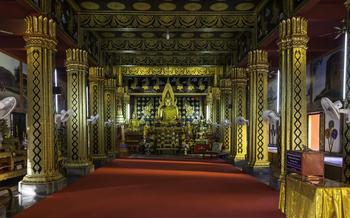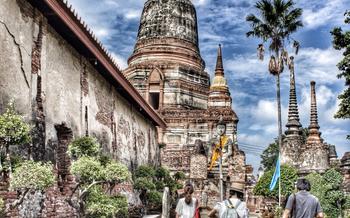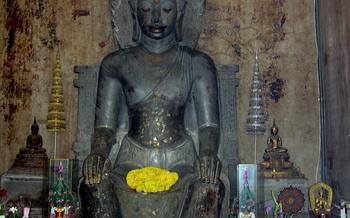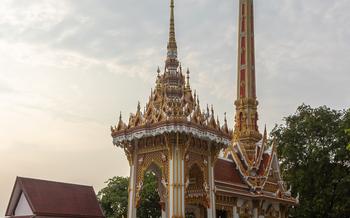
Wat Lahan Rai
- Wat Lahan Rai: A Sanctuary of Art, History, and Spirituality
- Architectural Marvels
- Impressive Buddha Images
- Ordination Hall and Meditation Center
- Sacred Relics and Artifacts
- Visitor Facilities and Accommodations
- Ethical and Respectful Behavior
- Photography and Social Media Etiquette
- Local Cuisine and Restaurants
- Shopping and Local Markets
- Nearby Attractions and Day Trips
- Sustainable and Responsible Tourism
Wat Lahan Rai: A Sanctuary of Art, History, and Spirituality
Historical Background:
Wat Lahan Rai, nestled in the tranquil landscapes of Rayong, Thailand, holds a profound significance in Thai Buddhism and local culture. Founded by the revered monk Luang Pu Sodh Candasaro in 1955, this sprawling temple complex has undergone remarkable development over the years, attracting visitors from around the world. Luang Pu Sodh, known for his devotion to meditation and spiritual teachings, envisioned Wat Lahan Rai as a sanctuary for spiritual practice and a repository of Buddhist art and culture. With his tireless efforts and the support of local communities, the temple gradually expanded, becoming an iconic landmark in the region. Today, Wat Lahan Rai stands as a testament to Luang Pu Sodh's dedication and the enduring legacy of Thai Buddhist traditions.
Architectural Marvels
Wat Lahan Rai stands out for its unique architectural features that blend traditional Thai and modern elements. The temple's design is a testament to the creativity and ingenuity of its founder, Luang Pu Sodh Candasaro. Visitors are immediately drawn to the temple's main structure, which resembles a giant conch shell. This conch shell-shaped building houses the ordination hall and is a symbol of purity and auspiciousness in Thai culture.
The temple grounds are adorned with numerous stupas of various sizes and shapes, each representing a different aspect of Buddhist teachings. These stupas are elaborately decorated with colorful tiles, intricate carvings, and golden spires. The use of glass and steel in the construction of some stupas adds a modern touch to the temple's overall design.
One of the most striking features of Wat Lahan Rai is its extensive use of mirrors. Mirrors are incorporated into the design of the temple's walls, ceilings, and even the Buddha images, creating a mesmerizing and kaleidoscopic effect. This use of mirrors symbolizes the temple's focus on inner reflection and self-awareness.
Wat Lahan Rai's architecture is a testament to the fusion of traditional Thai craftsmanship and modern design. The temple's unique features create an awe-inspiring and unforgettable experience for visitors.
Impressive Buddha Images
Wat Lahan Rai is home to a diverse collection of Buddha images, each possessing unique historical significance and artistic value. Among the most revered is the principal Buddha image, known as "Luang Pho Hong." This colossal bronze statue, measuring over 13 meters in height, emanates a serene and majestic presence. Believed to have been cast in the 19th century, Luang Pho Hong is a masterpiece of Thai craftsmanship, adorned with intricate engravings and precious gems.
Another notable Buddha image is "Luang Pho Thong," a seated Buddha crafted from pure gold. This exquisite statue exudes an aura of divinity and is believed to date back to the Ayutthaya period. Visitors are drawn to its resplendent beauty and the intricate details that adorn its surface.
In addition to these two primary Buddha images, Wat Lahan Rai houses numerous other statues, each representing a different aspect of Buddha's teachings or embodying a specific historical figure. These Buddha images vary in size, style, and materials, showcasing the diverse artistic traditions that have shaped Thai Buddhism throughout the centuries.
Whether visitors are drawn to the grandeur of Luang Pho Hong, the opulence of Luang Pho Thong, or the serene beauty of the smaller Buddha images, Wat Lahan Rai offers a profound experience of Buddhist art and devotion.
Ordination Hall and Meditation Center
Wat Lahan Rai houses a magnificent ordination hall, also known as the Ubosot, which serves as a sacred space for conducting Buddhist ceremonies, particularly ordinations. This grand hall is adorned with intricate carvings, colorful murals, and elegant stupas, showcasing the temple's artistic prowess. The Ubosot is a place of deep reverence, where monks and novices undergo the sacred ritual of becoming ordained into the Buddhist faith.
Adjacent to the ordination hall lies a tranquil meditation center, providing a serene sanctuary for spiritual practice and self-reflection. The center features dedicated meditation halls, where visitors can find solace and inner peace. Experienced meditation teachers guide visitors through various meditation techniques, helping them to cultivate mindfulness, compassion, and a deeper connection with their inner selves. Whether seeking spiritual guidance or simply moments of tranquility, the meditation center offers a welcoming space for all.
Sacred Relics and Artifacts
Wat Lahan Rai is home to a collection of sacred relics and artifacts that hold immense religious and historical significance. Among these treasures is a revered Buddha footprint, believed to be an imprint left by the Lord Buddha himself. This sacred relic is enshrined within a magnificent stupa, attracting countless pilgrims and devotees who come to pay homage and seek blessings.
Other notable relics include ancient scriptures, Buddha images, and personal belongings of Luang Pu Sodh Candasaro. These items offer a glimpse into the life and teachings of this revered monk, providing visitors with a deeper understanding of his spiritual journey and contributions to Thai Buddhism.
Legends and stories surround these sacred relics and artifacts, adding to their allure and mystique. According to local folklore, the Buddha footprint was discovered by a group of villagers who were guided by a mysterious dream. The scriptures, believed to be written by Luang Pu Sodh Candasaro himself, contain profound teachings on meditation, compassion, and the path to enlightenment.
Visitors to Wat Lahan Rai are encouraged to approach these sacred relics and artifacts with reverence and respect. By doing so, they not only honor the temple's rich history and traditions but also connect with the spiritual essence that permeates this sacred space.
Visitor Facilities and Accommodations
Wat Lahan Rai provides a range of visitor facilities to ensure a comfortable and convenient visit. Restrooms are available for both male and female visitors, ensuring privacy and cleanliness. Parking facilities are ample and well-organized, accommodating both cars and tour buses. Whether you're driving yourself or arriving as part of a group, you can be assured of finding a secure spot to leave your vehicle.
If you're planning to extend your stay in the area, there are several accommodations options near Wat Lahan Rai. From budget-friendly guesthouses to luxurious resorts, there's something to suit every budget and preference. Whether you seek simplicity or indulgence, you'll find a place to rest and recharge after a day of exploring the temple and its surroundings.
The temple is committed to accessibility and offers features to ensure that everyone can enjoy their visit. Ramps and designated pathways make it easy for visitors with disabilities to navigate the temple grounds, and accessible restrooms cater to their needs. The temple staff is also trained to assist visitors with disabilities, providing support and guidance whenever necessary.
Ethical and Respectful Behavior
When visiting Wat Lahan Rai, it is essential to be mindful of proper etiquette and respectful behavior. The temple is an active place of worship for many Thai Buddhists, and visitors should be considerate of their religious practices. Visitors should dress modestly, covering their shoulders and knees. Shoes should be removed before entering the temple's main buildings, and visitors should walk quietly and avoid talking loudly. It is also important to refrain from pointing feet or objects at Buddha images or monks. When taking photographs, visitors should always ask permission from the subjects and avoid using flash photography. It is also essential to be mindful of not blocking the paths of monks or other visitors during ceremonies or meditation sessions. By following these guidelines, visitors can show their respect for the temple and its community and ensure a harmonious and peaceful visit.
Photography and Social Media Etiquette
Wat Lahan Rai is a sacred and revered place of worship for many Buddhists. While photography is generally permitted, it is essential to be mindful of the temple's sanctity and the privacy of other visitors. Photography should be done respectfully and without causing any disturbance to the ongoing religious ceremonies or meditation practices.
When taking photographs, avoid using flash or tripods as they can be disruptive to others. It is also important to refrain from taking photos of monks or nuns without their consent. If you wish to capture a particular image, it is always polite to ask permission first.
Social media sharing is a great way to share your experiences and beautiful photos of Wat Lahan Rai with your friends and followers. However, it is crucial to remember that the temple is not merely a tourist attraction but a place of spiritual significance. When sharing photos on social media, be mindful of the privacy of others and avoid posting any images that may be considered disrespectful or offensive.
Always err on the side of caution and respect when using photography and social media at Wat Lahan Rai. By following these guidelines, you can ensure that your visit is both enjoyable and respectful of the temple's sacred atmosphere.
Local Cuisine and Restaurants
When visiting Wat Lahan Rai, don't miss the opportunity to explore the local cuisine and restaurants in the surrounding area. Rayong is known for its fresh seafood, tropical fruits, and delicious local dishes.
For a taste of authentic Thai cuisine, try some of the popular street food options available near the temple. Vendors selling pad thai, khao pad (fried rice), som tam (papaya salad), and grilled meats are a common sight. These dishes offer a delicious and affordable way to experience the flavors of Thailand.
If you're looking for a more formal dining experience, there are several restaurants in the area that serve both Thai and international cuisine. Many of these restaurants offer stunning views of the surrounding countryside, making for a memorable dining experience.
For vegetarians and vegans, there are several options available near Wat Lahan Rai. Local markets and restaurants often have a selection of fresh fruits, vegetables, and tofu dishes. Some restaurants also offer vegan-friendly versions of popular Thai dishes, such as pad thai and green curry.
When dining out in Rayong, be sure to try some of the local fruits, such as rambutans, mangosteens, and durians. These tropical fruits are a delicious and refreshing treat, and they can be found in local markets and restaurants throughout the region.
Shopping and Local Markets
In the vicinity of Wat Lahan Rai, visitors can immerse themselves in a vibrant shopping experience by exploring the local markets and souvenir shops. These markets offer a diverse range of souvenirs and handicrafts that reflect the rich cultural heritage of Rayong. From intricately carved wooden sculptures to colorful handmade textiles, there's something to suit every taste and budget.
For a truly authentic experience, visit the bustling Rayong Central Market, located just a short drive from the temple. This market is a treasure trove of fresh produce, local delicacies, and handmade goods. Visitors can savor the flavors of tropical fruits, sample freshly caught seafood, and browse through stalls selling traditional Thai clothing, ceramics, and handicrafts.
When shopping at local markets, remember to embrace the local culture by engaging in friendly bargaining. This is a common practice in Thailand and is often seen as a way to build rapport with the vendors. However, be respectful and mindful of local customs and traditions to ensure a positive and enjoyable shopping experience.
Nearby Attractions and Day Trips
Wat Lahan Rai is surrounded by a wealth of cultural and natural attractions that visitors can explore during their trip. For history enthusiasts, the ancient city of Mueang Boran is a must-visit destination. Located just a short drive from the temple, Mueang Boran is a vast outdoor museum showcasing replicas of Thailand's most iconic historical monuments. Visitors can wander through the park, admiring the intricate architecture and learning about the country's rich past.
Nature lovers will find plenty to explore in the nearby Khao Chamao-Khao Wong National Park. This beautiful park is home to a diverse range of flora and fauna, including lush forests, cascading waterfalls, and stunning viewpoints. Visitors can hike through the park's trails, spot exotic birds and wildlife, and take a refreshing dip in the cool waters of the waterfalls.
For a unique and immersive experience, visitors can embark on a day trip to Koh Samet, a picturesque island located just off the coast of Rayong. Known for its crystal-clear waters, pristine beaches, and vibrant coral reefs, Koh Samet is a paradise for beachgoers, snorkelers, and divers. Visitors can spend the day relaxing on the beach, exploring the island's hidden coves, or snorkeling among the colorful marine life.
To make the most of your day trips, consider renting a car or hiring a local tour guide. This will allow you to explore the attractions at your own pace and learn more about the local history and culture. Several tour companies offer day trips to Mueang Boran, Khao Chamao-Khao Wong National Park, and Koh Samet, providing a hassle-free and convenient way to experience these amazing destinations.
Sustainable and Responsible Tourism
As a responsible traveler, it's essential to practice sustainable tourism when visiting Wat Lahan Rai. Here are some tips to minimize your environmental impact and respect the local community:
-
Reduce Plastic Waste: Avoid using single-use plastic bags, straws, and water bottles. Bring your own reusable water bottle and shopping bags to reduce plastic waste.
-
Respect the Dress Code: Dress modestly and respectfully when visiting the temple. Avoid wearing shorts, tank tops, or revealing clothing.
-
Be Mindful of Noise: Keep your voice down and avoid loud conversations or noises that may disturb other visitors or monks.
-
Support Local Businesses: Support the local economy by purchasing souvenirs and handicrafts from local vendors. Look for products that are ethically made and support fair trade practices.
-
Respect the Environment: Dispose of your trash properly and avoid littering. Be mindful of your water and energy consumption, and conserve resources whenever possible.
By following these tips, you can help preserve the beauty and tranquility of Wat Lahan Rai for future generations while supporting the local community and promoting sustainable tourism.





